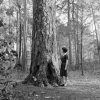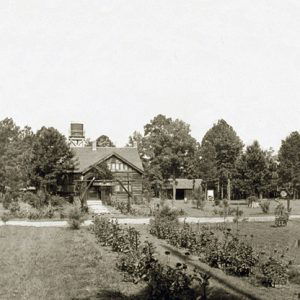calsfoundation@cals.org
Experimental Forests
Experimental forests are timbered lands that have been established primarily for scientific research and demonstration projects in which forest conditions are manipulated. In effect, experimental forests are long-term “laboratories” for testing environmental responses to silvicultural treatments, including thinning, tree regeneration, final harvesting, site preparation, herbicide and fertilizer applications, and other actions. In addition to controlled and replicated research trials, most experimental forests have areas dedicated to the “demonstration” of forestry techniques on an operational scale.
As of 2021, four experimental forests in Arkansas are operated by the Southern Research Station of the U.S. Department of Agriculture’s Forest Service (USFS): the 4,281-acre Alum Creek Experimental Forest near Jessieville (Garland County), the 1,675-acre Crossett Experimental Forest south of Crossett (Ashley County), the 720-acre Henry R. Koen Experimental Forest near Jasper (Newton County), and the 4,290-acre Sylamore Experimental Forest near Mountain View (Stone County). These experimental areas were formally established between 1934 and 1959 using procedures in USFS regulations that geographically identify them and direct their future operations.
The Alum Creek Experimental Forest (ACEF) was established in the late 1950s in the Ouachita National Forest to study the interactions of timber management on hydrology. To accomplish this, between 1960 and 1979, ten research watersheds (from one to thirty acres in size) and two weather stations were established. These were used in a series of studies on the effects of forest management on streamflow. In 1994, the ACEF was incorporated in the large-scale portion of a study of ecosystem management on the Ouachita National Forest. Over the years, a partial list of the research utilizing data from the ACEF includes studies of the impact of silvicultural practices on wildlife, stream yield, and water quality; the effect of pine-bluestem ecosystem restoration on watersheds; and the influence of forest conditions on soil development. Long-term hydrometeorological and vegetative data from the ACEF are currently available for study.
The Henry R. Koen Experimental Forest (KEF), named after a former Ozark National Forest supervisor, was established in the Ozark National Forest on the south bank of the Buffalo River in 1951. Most research on the KEF occurred between the 1940s and 1980, with the work focusing on upland hardwood-dominated ecosystems and more limited studies on shortleaf pine reproduction, establishment, and release from competition. Hydrology research was also conducted in the KEF, with some instrumentation used on seven small-gauged watersheds (less than twenty-five acres). Today, the KEF serves as the primary Arkansas fieldwork base for the Southern Research Station’s upland hardwood research unit.
The Sylamore Experimental Forest (SEF), established on March 28, 1934, by the USFS’s Central States Forest Experiment Station, is also located in the Ozark National Forest. The forests of the SEF are dominated by hardwoods, especially oaks, and some of the drier south-facing slopes have a significant shortleaf pine component. Over the years, forestry research projects on the SEF have been focused on oak regeneration and the development of oak-dominated stands, including the utilization of these stands for wildlife habitat. The SEF is also now operated by the upland hardwood research unit of the Southern Research Station.
Work on the Irons Fork Experimental Forest, located in the Ouachita National Forest in Polk and Scott counties about eight miles west of Oden (Montgomery County), began about 1936. The Irons Fork Experimental Forest was officially established in 1940 but soon lost staff and resources to the war effort, and by 1943 active research had ceased. The Irons Fork Experimental Forest formally closed in 1969.
Unlike the other federal experimental forests in Arkansas that were taken from national forests, the Crossett Experimental Forest (CEF) opened late in 1933 on property initially leased from the Crossett Lumber Company. Approximately seven miles south of Crossett, the lands that became the CEF were cut-over before 1920 by loggers of the Crossett Lumber Company. By the early 1930s, the Crossett Lumber Company decided to try sustainable forestry on its properties but was uncertain about how to implement this across their ownership. The company agreed to a long-term arrangement with the Southern Forest Experiment Station of the USFS that gave the federal government the land in exchange for the standing volume of the timber and a promise to maintain a research presence in the CEF for the next fifty years. Most of the facilities and much of the infrastructure still used today in the CEF were built before World War II by crews from the Civilian Conservation Corps (CCC), the Federal Emergency Relief Administration (FERA), and the Works Progress Administration (WPA).
Russ Reynolds was the first director of the CEF, and his primary objective was to develop the silvicultural practices needed to manage the cut-over second-growth loblolly/shortleaf pine and hardwood stands in a manner that rehabilitated existing stands while simultaneously providing landowners with revenues from timber harvesting. Since the inception of the CEF, scores of studies on various aspects of pine silviculture have been implemented, monitored, and published. For instance, most of what is known about uneven-aged management in naturally regenerated stands of loblolly and shortleaf pine was learned from research projects on the CEF. In particular, in 1937, two forty-acre parcels collectively called the “Farm Forestry Forties” were placed into a long-term study on uneven-aged pine silviculture. During their first thirty-two years, these cut-over stands were rehabilitated back into well-stocked, productive timberlands with annual harvests of carefully selected individual pines. Since then, these stands have been cut periodically (about once every five years) to show small private landowners how they can sustainably and profitably extract high-quality sawtimber from their woodlots.
The federal government is not the only public agency in Arkansas that maintains research-oriented forests. The Agricultural Experiment Station of the University of Arkansas System operates a number of outdoor research facilities across the state, many that have large forested areas and engage in long-term forestry research. For instance, the Southwest Research and Extension Center (SWREC) near Hope (Hempstead County) was established in the mid-1920s to work with fruits, vegetables, and row crops. As this research center expanded and diversified its mission, forestry became one of the avenues of experimentation over the years. Studies on various silvicultural techniques (with both even- and uneven-aged stands), fertilization, tree regeneration, and stand development have been conducted at the SWREC for decades. Other locations of the University of Arkansas System with forestry research include the Livestock and Forestry Branch Station at Batesville (Independence County), the School of Forestry at the University of Arkansas at Monticello (UAM) in Drew County, the Pine Tree Research Station at Colt (St. Francis County), and the Savoy Research Unit at Savoy (Washington County).
For additional information:
Adams, Mary B., Linda Loughry, and Linda Plaugher, compilers. Experimental Forests and Ranges of the USDA Forest Service. General Technical Report NE-321. Newtown Square, PA: USDA Forest Service, Northeastern Research Station, 2004.
Baker, James B., and Larry M. Bishop. Crossett Demonstration Forest Guide. General Report R8-GR 6. Atlanta, GA: USDA Forest Service, Southern Region, 1986.
Reynolds, Russell R. The Crossett Story: The Beginnings of Forestry in Southern Arkansas and Northern Louisiana. General Technical Report SO-32. New Orleans: USDA Forest Service, Southern Forest Experiment Station, 1980.
Xiao, Jinfeng, Ge Sun, Kevin M. Potter, Johnny Boggs, Qingyuan Zhang, Steven G. McNulty. “Do Experimental Forests and Ranges of the Southeastern United States Represent the Climate, Ecosystem Structure, and Ecosystem Functions of the Region?” Journal of Forestry, September 2, 2024. https://doi.org/10.1093/jofore/fvae020 (accessed September 5, 2024).
Don C. Bragg
USDA Forest Service
Southern Research Station








Comments
No comments on this entry yet.